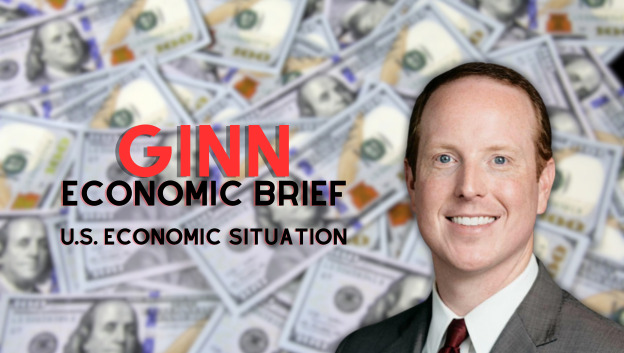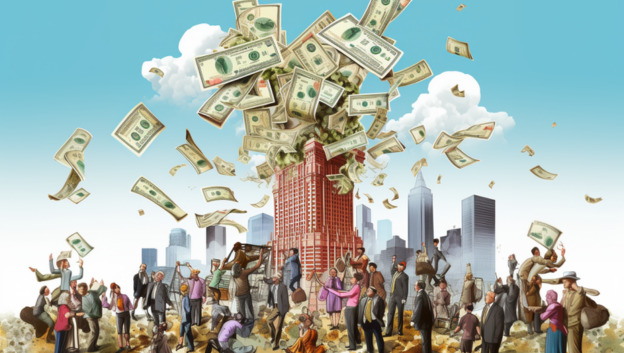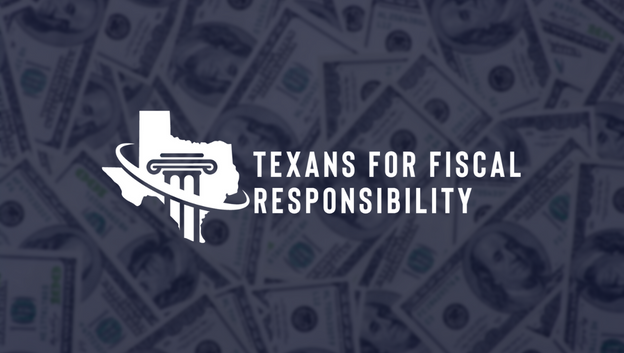
Highlights
- People prosper most from free-market capitalism, we need more of it in America (and Texas).
- Americans are suffering from big-government policies out of D.C.
- Find out more details and what can be done in this economic brief.
Figure 1: Real Average Weekly Earnings Declined Year-Over-Year for 26 Months Before Being Up in Four but Fell Again Last Month and Remain Down 5% Since January 2021

Overview
- Government failures drove the “shutdown recession” and the stagflationary period over the last few years that has plagued Americans, with more inflationary and recessionary problems coming.
- To overcome these government failures, there should be pro-growth policies of less spending by Congress, less regulation by the Biden administration, and less money printing by the Fed.
Labor Market
The Bureau of Labor Statistics recently released its U.S. jobs report for October 2023, which was another mixed report with some strengths but many weaknesses.
- The establishment survey is the most reported.
- There were +150,000 net nonfarm jobs added in August to 156.9 million employees, which has increased by +2.9 million over the last year and +4.5 million since February 2020. However, there continue to be large revisions for previous months as the data used for seasonal adjustments are from the last few years when there was substantial volatility in the labor market.
- August job gains were revised lower by 62,000 to 165,000 added and September’s was revised down by 39,000 to 297,000 added, for a total of 101,000 fewer job gains over those two months. Subtracting those revisions from the October report, only +49,000 new jobs were added.
- Last month, there were +99,000 jobs added in the private sector and +51,000 jobs added in the government sector. Most of the private sector jobs were added in the private education and health services sector (+89,000), which are mostly lower-paid jobs and dominated by government-related employment. For the month, there were job losses in manufacturing (-35,000), transportation and warehousing (-12,100), information (-9,000), financial activities (-2,000), and other services (1,000).
- Over the last year, private education and health services (+1.0 million), government (+630,000), and leisure and hospitality (+587,000) led the way, with information (-89,000) and transportation and warehousing (-55,500) losing jobs.

- The household survey is important but often not reported.
- Employment fell by -348,000 jobs in October to 161.2 million employed. There have been declines in net employment in five of the last 19 months for a total increase of +2.9 million since March 2022 and +2.5 million since February 2020, which is well below the jobs added in the establishment survey for many reasons.
- The labor force declined by -201,000 last month to 167.7 million. The labor force has declined in seven of the last 19 months and is up +3.4 million since March 2022. The unemployed increased by +146,000 last month, bringing the official U3 unemployment rate up to 3.9%, and the broader U6 underutilization rate rose to 7.2%.
- Since February 2020, the prime-age (25-54 years old) employment-population ratio has been flat at 80.6% after declining last month by 0.3 percentage points, the prime-age labor force participation rate was 0.3 percentage points higher at 83.3%, and the total labor-force participation rate was 0.6-percentage-points lower at 62.7% with millions of people out of the labor force holding the U3 rate artificially low.
Economic Growth
The U.S. Bureau of Economic Analysis recently released the initial estimate for economic output in the third quarter of 2023.
- Table 1 provides data over time for real total gross domestic product (GDP), measured in chained 2012 dollars, and real private GDP, which excludes government consumption expenditures and gross investment.
Table 1: Economic Output, Growth, and Inflation
| Q4/Q4 2021 | Q4/Q4 2022 | Q1:2022 | Q2:2022 | Q3:2022 | Q4:2022 | Q1:2023 | Q2:2023 | Q3:2023 | |
|---|---|---|---|---|---|---|---|---|---|
| Real total GDP (end of period) | $21.8T | $22.0T | $21.7T | $21.7T | $21.9T | $22.0T | $22.1T | $22.2T | $22.5T |
| Annualized growth (avg for period) | +5.4% | +0.7% | -2.0% | -0.6% | +2.7% | +2.6% | +2.2% | +2.1% | +4.9% |
| Real private GDP (end of period) | $18.2T | $18.3T | $18.1T | $18.1T | $18.2T | $18.3T | $18.4T | $18.4T | $18.4T |
| Annualized growth (avg for period) | +6.6% | +0.6% | -1.8% | -0.3% | +2.6% | +2.0% | +1.7% | +1.8% | +4.9% |
| GDP implicit inflation (avg for period) | +6.2% | +6.4% | +8.4% | +9.1% | +4.4% | +3.9% | +3.9% | +1.7% | +3.5% |
While the real total GDP growth rate of 4.9% in the third quarter of 2023 is the fastest pace since the fourth quarter of 2021 at 7%, there is underlying weakness. This weakness is driven by the contributions to this growth from government spending of 0.8 percentage points and change in volatile private inventories of 1.3 percentage points. Excluding government spending that is taken from the economy and private inventories, which indicate fewer inventory purchases next period, the real total GDP growth would be just 2.8%. Moreover, the inflation rate of 3.5% last quarter signals higher prices, which will further distort the economy and create more reason for the Federal Reserve to tighten its monetary policy. Another key measure of economic activity is the real average of GDP and GDI, which accounts for domestic production and income, but it won’t be released until November 29. The previous figure for the second quarter showed an increase of just 1.4%. This important measure has declined in three of the last six quarters, increasing this value by only 1.2% since the first quarter of 2022, likely when the recession started.
Meanwhile, the federal budget deficit is growing faster because of overspending and declining tax collections from a weak economy (See Figure 2). The national debt has ballooned to $33.7 trillion, and net interest payments on the debt will soon be a top federal expenditure, rising to above $1 trillion in October. Just since June 2023, the debt held by the public has increased by $1.9 trillion and by more than half of a trillion dollars in just the last two months, per the Economic Policy Innovation Center.
Figure 2: Fiscal Crisis Is Led by Spending Problem

The Federal Reserve has monetized, or printed, much of the new debt to keep interest rates artificially lower than where the market would have them. This continued to create higher inflation as too much money chased too few goods and services. This has been exacerbated as production has been overregulated and overtaxed, and workers have been given too many handouts. The Fed will need to cut its balance sheet (total assets over time) more aggressively if it is to stop manipulating markets (see this for types of assets on its balance sheet) and persistently tame inflation.
The current annual inflation rate of the consumer price index (CPI) has been cooling since a peak of +9.1% in June 2022 but remains elevated at 3.2% in October, which remains too high, as are other key measures of inflation. Just as inflation is always and everywhere a monetary phenomenon, deficits and high taxes are always and everywhere a spending problem. David Boaz at Cato Institute has noted how this problem is from both Republicans and Democrats (See Figure 3).
Figure 3: Rising Deficit-Spending Results from Democrats and Republicans

In order to get control of this fiscal crisis which is contributing to a monetary crisis, the U.S. needs a fiscal rule like the Responsible American Budget (RAB) with a maximum spending limit based on the rate of population growth plus inflation. This was recently released as part of Americans for Tax Reform’s Sustainable Budget Project, which highlights the benefits of this approach at the federal, state, and local levels. If Congress had followed this approach from 2003 to 2022, Figure 4 shows tax receipts, spending, and spending adjusted for only population growth plus chained-CPI inflation. Instead of an (updated) $19.0 trillion national debt increase, there could have been only a $500 billion debt increase for a $18.5 trillion swing in a positive direction that would have substantially reduced the cost of this debt to Americans. The Republican Study Committee recently noted the strength of this type of fiscal rule in its FY 2023 “Blueprint to Save America.” And to top this off, the Federal Reserve should follow a monetary rule so that the costly discretion stops creating booms and busts.
Figure 4: Federal Budget Gap Shrinks If Spending Limited to Population Growth Plus Inflation

Bottom Line
The stagflationary destruction will continue given the “zombie economy” and the unraveling of the banking sector which will hit main street hard. Instead of passing massive spending bills, the path forward should include pro-growth policies that shrink government rather than big-government, progressive policies. It’s time for a limited government with sound fiscal and monetary policy that provides more opportunities for people to work and have more paths out of poverty.
Recommendations:
- pro-growth policy path with less spending, regulating, and taxing at all levels of government, which includes return-to-work policies.
- Reject new spending packages that America cannot afford nor needs; pass the RAB instead.
- Impose a strict monetary rule with the Fed having a much smaller balance sheet and a much higher federal funds rate target until we End the Fed.
Texans for Fiscal Responsibility relies on the support of private donors across the Lone Star State in order to promote fiscal responsibility and pro-taxpayer government in Texas. Please consider supporting our efforts! Thank you!
Get The Fiscal Note, our free weekly roll-up on all the current events that could impact your wallet. Subscribe today




